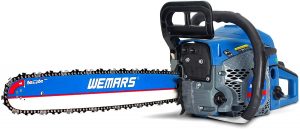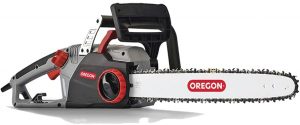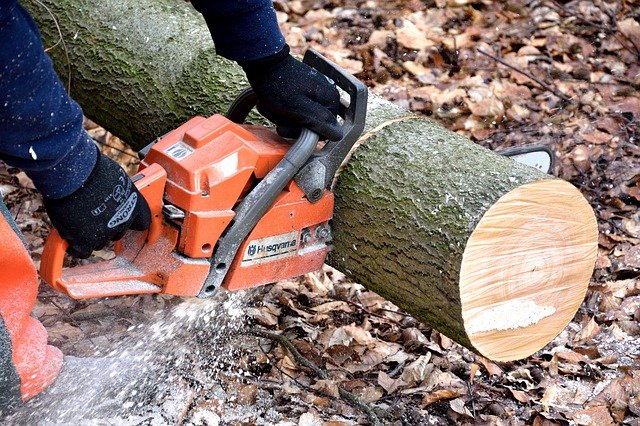Welcome to my article about gas vs electric chainsaws! Below I’ll go through the similarities and differences between these two chainsaws in detail, and discuss the pros and cons of each.
But first, a summary and a comparison table so you can quickly get an understanding of each of them.
Contents
Gas vs Electric Chainsaws – A Quick Summary
A gas chainsaw is more powerful than an electric chainsaw, but is also more heavy and requires regular refuelling. An electric chainsaw will run for as long as it’s plugged in (or as long as the battery lasts if it’s battery powered), however it’s suitable only for light-duty jobs and is less mobile than it’s gas counterpart.
Now here is a comparison table so that you can compare gas and electric chainsaws side by side:
Gas vs Electric Chainsaws – Comparison Table
If you’re on mobile, scroll across the table with your finger!
 |  |
|
Gas Chainsaws
What is a Gas Chainsaw?

As the name suggests, gas chainsaws are chainsaws that run on gas.
They are great for heavy duty work and can cut through large trees.
They come with a range or bar lengths that make them extremely versatile.
And, because they don’t require a cord, you have freedom of movement when you use them, and you don’t need to recharge them.
How Does a Gas Chainsaw Work?
Gas chainsaws contain a fuel tank which is located next to the engine shroud.
Fuel tank capacities typically range from 0.7 to 1 pint.
The run time will depend on the load, the power output, the cylinder displacement and the engine’s fuel efficiency. But generally, they will run for 15-20 minutes on a full tank of gas.
The chainsaws have bars of varying lengths, but the average is 16 – 18”.
The bar has teeth that cut through wood. The teeth run along the blade in a circular motion while its grooves cut through surfaces.
The horsepower of the saw and the speed it runs at will affect the speed at which the teeth run along the blade.
A chainsaw will work differently depending on whether you are using a 2 cycle of 4 cycle saw.
If you are using the 2-cycle, you will need to mix oil and gasoline and pour the solution into the tank. This will lubricate the engine components and feed the engine.
A 4-cycle chainsaw has two different tanks for oil and gas, so you don’t need to mix them.
Once fuel is added, the following occurs:
- The fuel moves through the carburetor to mix with the air.
- The air and fuel mixture makes its way into the cylinder where it’s ignited by a spark plug.
- The mixture burns and releases energy that pushes a piston back and forth.
- A connecting rod converts the pistons motion into a rotary motion.
- A drive shaft transfers the power to the centrifugal clutch which connects the engine to the chain causing it to spin around the guide bar.
Pros of a Gas Chainsaw
A gas chainsaw offers several benefits. Here are some to consider:
- They are good for heavy duty work including pruning, trimming, cutting down trees, slicing firewood and more.
- Their blade lengths vary in size and can be up to 72” long.
- They’re faster than electric or battery-operated chainsaws
- Their lack of a cord makes them highly mobile.
- With the right amount of fuel, they can run all day.
Cons of a Gas Chainsaw
Now here are some disadvantages to consider:
- They are heavier than an electric chainsaw which makes them difficult to use over long periods of time.
- If you want to keep them powered, you must carry the fuel around with you.
- The have a gasoline smell and emit smoke.
- They are extremely loud requiring users to wear hearing protection devices when sawing.
- They are more expensive than electric chainsaws but comparable in price to battery chainsaws.
- They require engine maintenance.
- They use a pull start cord which can become difficult to operate when the saw gets older.
- They require a specific fuel and oil mixture if you are using a 2-cycle engine.
Common Uses for a Gas Chainsaw
Gas chainsaws are extremely powerful and work best on medium to large sized jobs.
You can use them to perform commercial and residential work.
They can cut down fences, trees and do an entire day’s worth of landscaping work.
Electric Chainsaw
What is an Electric Chainsaw?

As the name suggests, an electric chainsaw runs on electricity.
They are lighter and more compact than gas chainsaws and they start with the touch of a button.
However, they are not as powerful as gas chainsaws and are best for smaller jobs.
How Does an Electric Chainsaw Work?
Electric chainsaws come in corded and cordless varieties.
Corded chainsaws run on electricity while cordless chainsaws run on batteries.
They are powered by an electrical motor that makes the teeth run along the blade.
The motor in an electrical chainsaw does not have moving parts.
Rather, an armature produces power that converts electricity into torque.
The torque transfers to a shaft inside the chainsaw that causes the chain to spin around the blade.
Pros of an Electrical Chainsaw
An electrical chainsaw provides many benefits including the following:
- They are compact and lightweight so a person of any size can use them for long periods of time.
- They are relatively quiet and will only make a lot of noise when you pull the throttle trigger.
- They don’t require you to carry around a tank of fuel.
- They don’t produce smoke or emit a smell.
- They are good for smaller tasks around the home.
- There is no fuel to mix, filters to clean or engine parts to oil. This makes them a low maintenance option.
- They are easy to store. Just turn them off, unplug them and put them anywhere they fit.
- They are cheaper than gas and battery powered chain saws coming in around one third of the price.
- Electric chainsaws will run as long as they are plugged in. Battery operated ones will last for 30 minutes to an hour before they need to be recharged.
Cons of an Electric Chainsaw
Now here are some downsides to consider:
- The longest electric chainsaw bar you will find is around 18”. This means you will not find one with the power and length to cut down large trees.
- They cut slowly and can take a long time to perform large tasks causing the user to tire out.
- Corded electric chainsaws are limited in how far you can take them.
- Battery powered chainsaws are limited in how long they will run on a single charge.
Common Uses for an Electric Chainsaw
Electric chainsaws are best used for small to medium sized jobs.
You can use them for light landscaping work and to cut thin boughs off trees.
They are also good for cutting small logs for firewood.
Which One Should You Use?
I hope this article about gas vs electric chainsaws has helped you identify which kind of chainsaw you need. The saw you use will depend on the task ahead of you.
If you are looking to do light yardwork or small jobs around the house, an electric saw will be your best option.
If you are performing more intensive duties, like chopping down trees or working on large projects, go for the gas chainsaw.
Here are some related articles you may also enjoy:
Jigsaw vs Circular Saw
Pin Nailer vs Brad Nailer

About The Author: Hi There! I’m Dave. I’m a certified millworker and carpenter, and have been working in the industry for over 10 years. I created this website to pass on my knowledge so that other enthusiasts, no matter what their skill level, can enjoy the craft as much as I do. I hope you enjoy!

